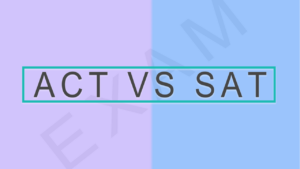Many high school students feel that SAT and SAT Subject tests are the same. While over the years, the differences between these two have dwindled significantly, you can figure them out once you delve deeper. But before we talk about the difference, it is vital to understand that both of these exams are dedicated to testing the candidate’s expertise and enabling the college to understand if they are a good fit. It is unlikely that you need to appear for both the exams because while SAT is a general exam, SAT Subject Test list is focused on establishing expertise in specific subjects. This article discusses the Difference Between SAT And SAT Subject Test.
Details of the SAT Exam
The SAT exam (or SAT Reasoning Test) stands for Scholastic Assessment Test. It was started in 1926 by a private and non-profiling college board. Either SAT or ACT exams are part of the college admissions process of most colleges. The SAT is an entrance exam used by education institutes to measure the college readiness of high school students for their curriculum. It is a multiple-choice, offline standardised test created to provide a common ground for comparing the proficiency of all applicants. The regular SAT is a three-hour long exam divided into two parts – maths and evidence-based reading and writing. The SAT sections are 800 points each. SAT Test Duration The SAT exam is an ancillary addition to the list of admission requirements that includes GPA score, GRE score, IELTS/TOEFL score for English proficiency, LOR, ACT scores, and others. The highest SAT score is 1600, but the average score for testing requirements is 1060. It is made up of 5 sections, which include –
- Critical Reading
- Writing and Language
- Maths with Calculator
- Maths without Calculator
- Optional essay
The last day to register for the SAT lies approximately five weeks before the test date. You can register online on the College Board’s official website, and it may require you to complete the registration by mail under exceptional circumstances.
Details of the SAT Subject Test
The SAT Subject Test or SAT 2 is a five-subject, one-hour each, entrance exam that focuses more on a particular subject area to understand the applicant’s proficiency in some specific areas. The Subject Test is available in 20 subjects in 5 key areas. The areas covered include –
- Mathematics
- English
- History
- Science and
- Languages
The Subject Test is a multiple answer choice exam of 800 marks for each part, and has anywhere between 50 and 95 questions, depending on the speciality you are sitting for. The average SAT Subject Test scores range between 600 and 720, depending on the proficiency. In most cases, two SAT Subject Tests are made compulsory by colleges – one in Science and the other one in Math. Most of the course coverage includes items taught in high schools and skips adding advanced level tests, such as in AP, where college intro coursework is also added. The SAT Subject Test dates are different from that of SAT and can be taken in October or November. You can take up to three of them in a day. You can register for the SAT Subject Tests offered by the College Board after going through the application deadlines offered by the plethora of colleges. Applicants cannot take SAT and SAT Subject Dates exams on the same date.
Difference Between SAT & SAT Subject Test
When first introduced, SAT was meant to test the applicant’s aptitude, whereas SAT 2 was more towards testing achievement. However, once the College Board took charge, it changed the SAT to be a reasoning test, thereby reducing the gap between SAT (old name ‘SAT 1’) and SAT Subject Tests. But with massive changes in 2016, the SAT became an exam focused on testing the fundamental knowledge of the candidates. It somehow established the actual Difference Between SAT And SAT Subject Test. Listed below are critical differences between SAT and SAT Subject Tests –
Primary Emphasis
SAT is considered an aptitude test, whereas SAT Subject Tests are considered an achievement test.
Primary Prerogative
Colleges support SAT for making admission decisions and award scholarships to worthy students. In comparison, SAT Subject Tests are used for admissions and course placement.
Length
The total length of SAT is three hours without the optional essay section and three hours fifty minutes with the essay. In comparison, each component of the SAT Subject Tests spans an hour.
Frequency
You can appear for the SAT seven times a year, whereas the SAT Subject Test takes place six times per year, but you need to know that not all subjects are offered every time.
Scale of Marks
You can score anything between 400 and 1600 on the SAT. In comparison, SAT Subject Tests are for individual subjects, and their scoring range is between 200 and 800.
Penalty for Incorrect Answers
SAT Applicants do not have to pay the penalty for incorrect answers. A small fraction of marks is subtracted for each incorrect answer in the SAT Subject Tests. Here are the marks deducted –
- ¼ point for every incorrect five-choice question
- 1/3 point for every incorrect four-choice question
- ½ point for every incorrect three-choice question
Subject Matter
The emphasis of SAT is on reading, writing, and maths, whereas there are 20 different subject tests to choose from with SAT 2.
List of Colleges
Almost all colleges require SAT. However, only very selective colleges’ class admission processes include SAT Subject Tests.
Conclusion
SAT and SAT Subject Tests are different in many ways. While both are multiple-choice, the format differs depending on the subject you choose for the latter and often comes with special instructions. They also vary in length and coverage, and emphasis. So, it is imperative for you to understand your requirements before applying for either of them and check if the college you are applying to has them as compulsory or otherwise. At LeapsScholar, we have had a proven history of students excelling at SAT and SAT Subject Tests after getting one-on-one counselling sessions with our experts. If you are struggling with what to choose and how to choose between SAT and SAT Subject Tests, we have a free counselling session lined up to help you get rid of your uncertainties.
Frequently asked questions
Which SAT subject tests are the easiest?
Maths Level 2 and languages can be difficult to crack for most people. In comparison, there are certain SAT subjects that are considered easy to prepare. Here is the list –
Biology E
United States History
Biology M
Chemistry
World History
Are AP class tests harder than SAT Subject Tests?
The general consensus is that AP tests prep is usually more complex than SAT Subject Tests material. The primary reason for it is the former testing a student’s college readiness and requires mastery of college-level work and subjects. In contrast, SAT Subject Tests are for higher school applicants and are available as different subject tests.
Is SAT a multiple-choice exam?
The SAT is an entrance test exam for colleges and universities aspiring students. It is a multiple-choice exam that helps the applicants fulfil their dream of studying at a specific college.
Are there listening subjects in SAT Subject Tests?
If you choose languages as your speciality, you can choose from a plethora of courses that include listening. Courses such as French and French with Learning, Spanish and Spanish with Listening, and Korean with Listening help you polish your precision of vocabulary while reading and writing the specific language.







